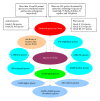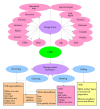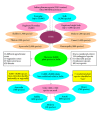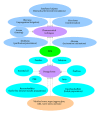Historical perspective of traditional indigenous medical practices: the current renaissance and conservation of herbal resources - PubMed (original) (raw)
Review
Historical perspective of traditional indigenous medical practices: the current renaissance and conservation of herbal resources
Si-Yuan Pan et al. Evid Based Complement Alternat Med. 2014.
Abstract
In recent years, increasing numbers of people have been choosing herbal medicines or products to improve their health conditions, either alone or in combination with others. Herbs are staging a comeback and herbal "renaissance" occurs all over the world. According to the World Health Organization, 75% of the world's populations are using herbs for basic healthcare needs. Since the dawn of mankind, in fact, the use of herbs/plants has offered an effective medicine for the treatment of illnesses. Moreover, many conventional/pharmaceutical drugs are derived directly from both nature and traditional remedies distributed around the world. Up to now, the practice of herbal medicine entails the use of more than 53,000 species, and a number of these are facing the threat of extinction due to overexploitation. This paper aims to provide a review of the history and status quo of Chinese, Indian, and Arabic herbal medicines in terms of their significant contribution to the health promotion in present-day over-populated and aging societies. Attention will be focused on the depletion of plant resources on earth in meeting the increasing demand for herbs.
Figures
Figure 1
Species and protected species in China.
Figure 2
Chinese herbal medicine (CHM) in China.
Figure 3
Dosage forms and pharmaceutical techniques in Chinese herbal medicine (CHM).
Figure 4
Styles of Chinese herbal medicine (CHM) in the global market (see also [62] of quasi-chemical model and [–65] of full-chemical model).
Figure 5
Some important texts of Indian herbal medicine [–78].
Figure 6
Plant species in India and Indian herbal medicine (IHM).
Figure 7
Dosage forms and pharmaceutical techniques in Indian herbal medicine (IHM) [99, 100].
Figure 8
Achievements of Arabic medicine and pharmacy [118, 119].
Figure 9
Past and present of Arabic herbal medicine [130].
Figure 10
Pharmacodynamic synergism and pharmacokinetic synergism of herbal medicines.
Figure 11
Classification of herbal medicines (HMs) in the international market.
Similar articles
- Emerging trends of herbal care in dentistry.
Kumar G, Jalaluddin M, Rout P, Mohanty R, Dileep CL. Kumar G, et al. J Clin Diagn Res. 2013 Aug;7(8):1827-9. doi: 10.7860/JCDR/2013/6339.3282. Epub 2013 Aug 1. J Clin Diagn Res. 2013. PMID: 24086929 Free PMC article. - [Development and expectation of modernization of herbal medicines].
Wang T. Wang T. Zhongguo Zhong Xi Yi Jie He Za Zhi. 2013 Aug;33(8):1018-29. Zhongguo Zhong Xi Yi Jie He Za Zhi. 2013. PMID: 24325047 Chinese. - Herbal panacea: The need for today in dentistry.
Seal M, Rishi R, Satish G, Divya KT, Talukdar P, Maniyar R. Seal M, et al. J Int Soc Prev Community Dent. 2016 Mar-Apr;6(2):105-9. doi: 10.4103/2231-0762.178744. J Int Soc Prev Community Dent. 2016. PMID: 27114947 Free PMC article. Review. - Nature's medicinal bounty: don't throw it away.
Akerele O. Akerele O. World Health Forum. 1993;14(4):390-5. World Health Forum. 1993. PMID: 8185790 - Diabetes mellitus and its management with medicinal plants: A perspective based on Iranian research.
Rezaei A, Farzadfard A, Amirahmadi A, Alemi M, Khademi M. Rezaei A, et al. J Ethnopharmacol. 2015 Dec 4;175:567-616. doi: 10.1016/j.jep.2015.08.010. Epub 2015 Aug 14. J Ethnopharmacol. 2015. PMID: 26283471 Review.
Cited by
- Comparison of the Effect of Auriculotherapy, a Herbal Compound (Aslagh Capsule), and Metformin on the Clinical Symptoms of Polycystic Ovary Syndrome: Randomized Clinical Trial.
Ghanbarian R, Valiani M, Allameh Z, Ranjbar M, Mazaheri M. Ghanbarian R, et al. Adv Biomed Res. 2024 Sep 23;13:75. doi: 10.4103/abr.abr_111_23. eCollection 2024. Adv Biomed Res. 2024. PMID: 39512409 Free PMC article. - Trade-off between herbal and allopathic treatments: An ethnopharmacological case study in Rema-kalenga wildlife sanctuary, Bangladesh.
Dey B, Ahmed R, Ferdous J, Ul Haque MM, Islam N, Haque A, Ahamed R. Dey B, et al. Heliyon. 2024 Oct 12;10(20):e39341. doi: 10.1016/j.heliyon.2024.e39341. eCollection 2024 Oct 30. Heliyon. 2024. PMID: 39497960 Free PMC article. - Phytochemical Analysis and Evaluation of Antioxidant, Antidiabetic, and Anti-inflammatory Properties of Aegle marmelos and Its Validation in an In-Vitro Cell Model.
Venkatesan S, Rajagopal A, Muthuswamy B, Mohan V, Manickam N. Venkatesan S, et al. Cureus. 2024 Sep 30;16(9):e70491. doi: 10.7759/cureus.70491. eCollection 2024 Sep. Cureus. 2024. PMID: 39479139 Free PMC article. - Methanol Extract of Thottea siliquosa (Lam.) Ding Hou Leaves Inhibits Carrageenan- and Formalin-Induced Paw Edema in Mice.
Renny A, Sidhic J, Tom A, Kuttithodi AM, Job JT, Rajagopal R, Alfarhan A, Narayanankutty A. Renny A, et al. Molecules. 2024 Oct 11;29(20):4800. doi: 10.3390/molecules29204800. Molecules. 2024. PMID: 39459169 Free PMC article. - Nature's weapons: Bioactive compounds as anti-cancer agents.
Auti A, Tathode M, Marino MM, Vitiello A, Ballini A, Miele F, Mazzone V, Ambrosino A, Boccellino M. Auti A, et al. AIMS Public Health. 2024 Jun 18;11(3):747-772. doi: 10.3934/publichealth.2024038. eCollection 2024. AIMS Public Health. 2024. PMID: 39416904 Free PMC article. Review.
References
- Botanic gardens conservation international. 2013 (Chinese), http://www.bgci.org/index.php?option=com_content&id=2016&status=published.
- Media Centre. Traditional Medicine, 2013, http://www.who.int/mediacentre/factsheets/fs134/en/
- Jack DB. One hundred years of aspirin. The Lancet. 1997;350(9075):437–439. - PubMed
- Falodun A. Herbal medicine in Africa-distribution, standardization and prospects. Research Journal of Phytochemistry. 2010;4(3):154–161.
- Leroi Gourhan A. The flowers found with Shanidar IV, a Neanderthal burial in Iraq. Science. 1975;190(4214):562–564.
Publication types
LinkOut - more resources
Full Text Sources
Other Literature Sources










